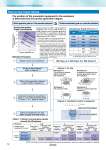
p-e07-11a-sun 81 / 94
10秒後にBOOKのページに移動します
Pneumatic Equipment for Clean Room The position of the pneumatic equipment to the workpiece is determined by the particle generation degree. Selection Procedure Determine the particle concentration grade no. around the workpiece based on above q to e. (Refer to Table 1.) Particle generation grade no. of the pneumatic equipment Required clean room cleanliness? ISO Class 4 or ISO Class 5 or ISO Class 6? Where is the pneumatic equipment located? (Refer to Diagram 2.) Air flow to the workpiece? (Refer to Diagram 1.) Diagram 1: Air flow Diagram 2: Installation location of equipment Select the equipment to be used. (Refer to pages 75 through to 84. ) Particle concentration grade no. around the workpiece Particle diameter (μm) Particle concentration (particles/m3) Particle Generation Grade Classification Cleanliness Grade (Reference) 105 104 103 102 10 0.1 0.5 1 1 Upper area of the workpiece Air flow Unstable area Stable area Workpiece Lower area of the workpiece : ISO Class 4 and 5 levels of cleanliness cannot be achieved in area due to dust accumulation or flotation. Table 1: Particle Concentration Grade around the Workpiece w Workpiece A, B C e Position of the equipment to be used Upper area of the workpiece Grade 1 Grade 2 Grade 3 Grade 2 Grade 1 Grade 3 Grade 4 Grade 2 Grade 3 Grade 2 Grade 1 Grade 3 Grade 4 Grade 3 Grade 2 Grade 2 Upper area of the workpiece Lower area of the workpiece Lower area of the workpiece Unstable area Stable area D Upper area of the workpiece Lower area of the workpiece q Cleanliness ISO Class 4 ISO Class 5 Unstable area Stable area Unstable area Stable area q w e r t Grade 4 (ISO Class 6 equivalent) Grade 3 (ISO Class 5 equivalent) Grade 2 (ISO Class 4 equivalent) Grade 1 (ISO Class 3 equivalent) ISO Class 6 How to Use Clean Series SMC Fed.Std.209E Note) SI unit Grade 1 Grade 2 Grade 3 Grade 4 . . M1.5 M2.5 M3.5 M4.5 M5.5 M6.5 ISO 14644-1 ISO Class 3 ISO Class 4 ISO Class 5 ISO Class 6 ISO Class 7 ISO Class 8 Note) Fed.Std.209E was abolished in Nov. 2001, so these figures are for reference only. Grading is based on SMC’s original system of designation, with a lower grade number indicating a smaller volume of particle generation. The information in parentheses indicates the upper limit of concentration for the cleanliness classes based on ISO 14644-1. For further details, refer to page 85 “Particle Generation Measuring Method” and page 86 “Comparison of Cleanliness Standards”. Note) In case of the one-touch fitting 10-KQ (that includes built-in one-touch fitting solenoid valve manifolds, and speed controllers with one-touch fittings), changes in internal pressure may cause the collet chuck to slide very slightly. This may result in particle generation, so please avoid using this item in Grade 1 or Grade 2 areas. However, there is no need for similar caution in the case of insert fittings (KF), miniature fittings (M/MS), clean one-touch fittings (KP/KPQ/KPG), or speed controllers with clean one-touch fittings (AS-FPQ/FPG). Workpiece C The air flows freely. Workpiece D The air is sucked under the workpiece. Workpiece A The air flow is blocked before it reaches the workpiece. Workpiece B Convection currents are frequently generated around the workpiece. 74